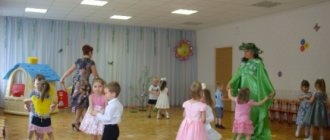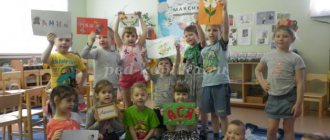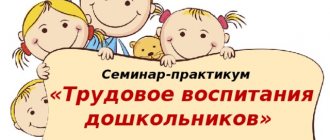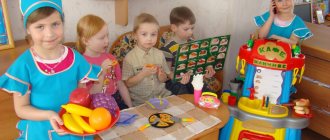The importance of entertainment for preschoolers in kindergarten
06 January 2021
Suleymanova Albina Nasimovna
Methodist
The article describes the types of entertainment according to the degree of activity of children's participation, the classification of entertainment according to content, the types and content of entertainment.
1. Entertainment and holidays in kindergarten are the most joyful and vibrant events in the life of a child. Childhood is, in fact, a time for fun.
2. Entertainment as one of the types of cultural and leisure activities is of a compensatory nature, compensating for the costs of everyday life and monotony of the environment.
3. Entertainment should always be a colorful moment in the lives of children, enriching impressions and developing creative activity.
4. Entertainment contributes to the aesthetic and all-round development of the child, since at this time he can get acquainted with various types of arts: musical, visual, literary, theatrical, etc.
5. Entertainment excites joyful feelings and develops emotions, elevates mood and vitality.
6. At such events, a child can show independence and gain self-confidence and faith in their capabilities.
7. At this time, his positive qualities are formed: goodwill, mutual assistance, respect for peers, sympathy, cheerfulness, etc.
8. The atmosphere of what is happening, the colorful design, costumes - all this has a positive effect on the aesthetic education of the child. Preparation for entertainment and holidays is carried out systematically and systematically, which allows the child to adapt to the rhythms of what is happening and not experience stress.
9. At the heart of every entertainment for children is a certain idea that must be conveyed to the child. The repertoire is carefully selected based on age characteristics.
10. Participation in them is a discipline and culture of communication. By learning poems and songs, children learn a lot of new things about the world around them, develop their horizons, memory, speech, and mental thinking.
11. Entertainment combines various types of art, which has a positive effect on the development of children’s senses and consciousness.
12. Preparing for holidays and entertainment, children experience a lot of positive emotions, which unite them with a common experience and teach collectivism and cohesion.
13. And most importantly, entertainment brings joy to children, which is so necessary for them at such a young age.
Types of entertainment according to the degree of activity of children's participation
- children are only listeners or spectators;
- children are direct participants;
- participants – adults and children.
Classification of entertainment by content:
- theatrical: puppet and shadow theaters, toy theater, flannelgraph, plane theater, musical theater, etc.;
- educational: Knowledge Day, Mother's Day, KVN, quizzes about the life and work of composers, artists, writers, actors, poets; about the customs and traditions of your country and people; environmental;
- sports: sports and recreation programs, attractions, programs with competitions and relay races, outdoor games
- concerts, musical and literary evenings
- folk holidays: Apple Day, Christmas, Maslenitsa, Easter, Trinity, Intercession.
Such entertaining moments help the teacher relieve fatigue in children and help switch attention from one type of cultural and leisure activity to another. Therefore, they can be carried out at any time when required to create a positive microclimate.
It is not necessary to gather all the children in the group for such fun fun. The teacher just needs to be able to see and feel a child who needs emotional release, or those who need to be cheered up or simply helped to choose an activity for themselves.
Notes to educators
The main advantage that you have in the process of entertaining children is their weak personal criticism and a high degree of interest, which is natural, active and strong. During the kindergarten period, children very rapidly strive for their individual development. Entertainment in kindergarten should be invented and organized according to the principle of maximum interest of the existing group of children.
A prerequisite is control and tracking of manifested emotions, attitudes, stability and degree of interest in a particular type of entertainment. It is also worth taking into account the diversified development of children, which includes physical, mental, personal, creative, and social qualities. Entertainment in kindergarten is formed in such a way that, taking into account the permissible physical and moral stress on children, it does not overload them, as this can lead to negative consequences.
Alternate between different types of entertainment, turning this process into a game. An important point that the teacher should take note is a positive attitude towards each child, which in return will cause greater mutual understanding between you and the children. This will promote good relationships, which will definitely affect education as a whole. Entertainment in kindergarten, its varieties, can be easily invented by yourself (the teacher). Ideas for this should be drawn from various sources - cartoons, movies, famous children's games, entertaining children's TV shows, books, the Internet, etc.
Even simple things like drawing or modeling clay can be quite a fun process if you approach it creatively and with some playfulness. Entertainment in kindergarten will take on, for the most part, an independent character when the teacher organizes several types of entertainment that the children will ultimately enjoy. They themselves will ask and lead these games, and the teacher will have to monitor the progress of the child’s development.
Types and content of entertainment evenings
The Soviet kindergarten had an interesting experience in organizing evenings of entertainment. They are organized at least once every 10 days in each group in the afternoon. Based on the nature of the participation of children and adults in them, these evenings are divided into three types:
- Evenings of entertainment prepared by adults for children.
- Evenings prepared by children.
- Mixed evenings of entertainment for both adults and children.
According to the form of organization, entertainment evenings are also divided into several types: entertainment, concerts and theme evenings, children's amateur performances, fun evenings and sports entertainment.
The variety of options for evening entertainment, created by the creativity of the teachers themselves, fills each of them with a unique originality. At evenings of a spectacular nature, familiar fairy tales are staged, stories and poems are read, and songs are sung. A puppet show can be prepared by older children. Even timid children willingly participate in it, although they are usually embarrassed to perform. After all, in this case they are behind the screen. Participation in such performances makes them more courageous, confident and sociable.
During evening concerts, children are organized to listen to music seriously. They are carried out mainly in older groups. The concert should consist of 4-5 pieces, mostly familiar to children. However, these works can be given in an unusual performance in order to introduce elements of novelty into them. A new piece can also be performed at the concert. There can be no more than 5-6 such concerts per year.
The content of thematic concerts are songs, poems, games, united by a single theme. For example, a concert on the theme “Autumn” can be held like this: children, at the request of the teacher, make autumn sketches. Then a concert is held about them. The themes of the concerts can be very different: “We are friendly guys”, “You can’t live without work”, “Flight to the Moon”, “Spring, spring on the street”, “Korney Chukovsky”, etc. At children’s amateur performance evenings, games familiar to children are used , songs, dances, poems. Their topics can be very diverse depending on the interests, knowledge and skills of preschoolers.
Children's amateur performances can also be timed to coincide with children's birthdays, which are traditionally held once a month in kindergartens. Preschoolers, together with their teachers and parents, secretly prepare birthday gifts (drawings, crafts) and perform poems, songs, and dances for them. The evening ends with tea and birthday cake. It is advisable to invite the parents of the birthday people to birthday parties. The content of the evenings of fun includes riddles, jokes, attraction games, funny dramatizations, dramatization games, musical fairy tale games, etc.
Sports evenings, which are held from the middle group, include children performing a variety of physical education tasks and participating in outdoor games. In senior groups, evenings of competitions, attractions, etc. are also organized. Such an evening lasts about half an hour.
The variety of entertainment evenings allows you to alternate them, filling children's lives with interesting and joyful events. When planning a particular evening of entertainment, the teacher, together with the music worker, thinks through and prepares for it (working with children, making the necessary attributes and decoration, etc.).
Share with friends
Non-traditional drawing techniques in kindergarten and their role in the development of preschool childrenFeatures of professional guidance for junior schoolchildren
You do not have sufficient rights to add comments
You must be logged in to post comments. If you do not yet have an account on our website, we invite you to register. It will take no more than 5 minutes.
Comments
Zakharova Olga Vyacheslavovna
20.01.2021 09:47
Thank you, the article is correct, informative, and succinctly constructed. Few teachers include entertainment in their work, and if they do, it is more like a regular activity.
Report to moderator
Content:
- Children's games at home
- Entertaining games for children at home: types
- Active games
- Sport games
- Competitions
- Games for development
- Speech games
- Construction of houses
- Math games
- Interesting games for two children
- Role-playing games
- Unusual home games
- Music games
- Water games
- Interesting games
- Recommendations for parents
Active games
Go!
Invite your child to imagine himself as a car driving along a dark road. To do this, place several chairs or other objects, give the child a steering wheel or a round substitute and blindfold him. You are the navigator, the baby is the car, turn on and go! Try switching places so that the child also tries himself in the role of an assistant.
Suitable for age: 5-8 years old.
Hold the ball
This children's game will require a balloon and a little dexterity. Task: move the ball from one end of the room/corridor to the other without touching it with your hands or letting it fall. Let the children be smart: you can blow on the ball, push it with your nose, chin, or knees.
If there are two children, arrange a competition to see who can get the ball to the finish line the fastest. For older participants, the task can be complicated by building a path or placing small obstacles that need to be avoided.
Suitable for age: 5-15 years old.
Cross the river
The role of the banks can be played by jump ropes, ribbons or two pieces of rope, laid out at a distance of one and a half to two meters from each other. Cut out circles from paper that will replace the pebbles.
Invite your child to “move” from one bank to the other, stepping on the stones without getting his feet wet. The game is simple, but perfectly develops coordination of movements in children 3-5 years old.
Suitable for age: 3-5 years old.
"Brilliant" basketball
In an apartment, entertaining games for children with a ball are not very convenient, but if you replace it with small foil balls and build a basket from a children's bucket or a cut-off five-liter bottle, you will get a pretty decent basketball.
The competition can be complicated: throw in turns with the left and right hand, count who will have the most hits per minute, vary the distance from the player to the basket.
Suitable for ages: 5-13 years old.
Classics
The good old “jumping rope” is definitely worth remembering and organizing a game even within an apartment or house. Using construction tape on the carpet, “draw” a classic; a round candy box can be used as a “bat.” The main thing is to remember about the neighbors below and try not to disturb their peace in the evening.
Suitable for age: 5-10 years old.
The fastest turtle
It's easy to turn into a turtle! Get on all fours, put a pillow on your back and forward to the finish line, so that your “shell” does not get lost along the way. You can arrange a competition “Who is faster?” or which of the “turtles” will show the best time.
Suitable for age: 4-7 years old.
Tricky ball
Throwing a ball within an apartment is not the safest activity, so you can come up with other activities with it. Lie on your stomach opposite each other, placing the ball between your heads. Try standing up while holding the ball together, without using your hands.
Another option would be a competition, in which case two balls would be required. Get on all fours and, on command, begin to roll the ball, touching it with your forehead or nose, without helping with your hands. The one who crosses the finish line faster will win.
Suitable for age: 5-10 years old.
Unusual home games
Family games at home can become a good tradition that will give your children a sea of warm memories in adulthood. And while they are still small, a little imagination, effort and time will help organize fun games and keep the whole family busy. Actively get involved in the preparation, don’t be lazy, come up with something to play, and before you know it, you’ll get carried away yourself.
Fantastic patterns
Mix 5 tablespoons of gouache, one tablespoon of shampoo (dishwashing liquid) and a teaspoon of water. Make a thick foam in the container by blowing into a plastic tube.
Now use a piece of paper to lightly touch the colored bubbles. See how the prints turn out and complete the abstract picture, following your imagination.
Suitable for age: 5-12 years old.
Fun quest
This activity can be prepared for a birthday or for a group of friends, or you can simply please your child with an exciting activity. And if the treasure hunter is interested in the search process, then, believe me, you will be no less fascinated by the preparation process.
Hide a small gift or sweet prize at home (there may be several of them) and create step-by-step instructions for finding them.
You can place notes with clues in the most unusual places, the main thing is that each previous one is the key to finding the next one and ultimately leads to the main “treasure”.
Suitable for ages: 6-12 years old.








